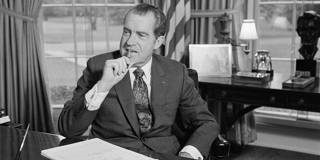US President Richard Nixon’s 1971 decision to end the US dollar’s convertibility into gold had such far-reaching consequences that it took policymakers decades to learn to manage the new system. Now, digital technologies are driving a new monetary revolution that could end the greenback’s global primacy altogether.
PRINCETON – We are approaching the 50th anniversary of the so-called Nixon Shock, one the most decisive ruptures in monetary history. On August 15, 1971, US President Richard Nixon announced in a televised address that he was “closing the gold window.” By ending the dollar’s convertibility into gold (at an official rate of $35 per ounce), Nixon severed the millennia-long link between money and precious metals.
This epochal event has uncanny resonances today. For example, just as Nixon was struggling to extricate the United States from its long, costly, and unwinnable war in Vietnam, US President Joe Biden has now ended America’s long, costly, and unwinnable intervention in Afghanistan.
Similarly, Nixon used his address to announce a policy program with goals similar to those being pursued by the Biden administration. “We must create more and better jobs,” he said, “we must stop the rise in the cost of living; we must protect the dollar from the attacks of international money speculators.”

PRINCETON – We are approaching the 50th anniversary of the so-called Nixon Shock, one the most decisive ruptures in monetary history. On August 15, 1971, US President Richard Nixon announced in a televised address that he was “closing the gold window.” By ending the dollar’s convertibility into gold (at an official rate of $35 per ounce), Nixon severed the millennia-long link between money and precious metals.
This epochal event has uncanny resonances today. For example, just as Nixon was struggling to extricate the United States from its long, costly, and unwinnable war in Vietnam, US President Joe Biden has now ended America’s long, costly, and unwinnable intervention in Afghanistan.
Similarly, Nixon used his address to announce a policy program with goals similar to those being pursued by the Biden administration. “We must create more and better jobs,” he said, “we must stop the rise in the cost of living; we must protect the dollar from the attacks of international money speculators.”